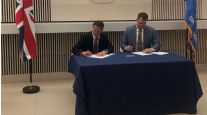Oklahoma DOT at Crossroads, Director Says
Mike Patterson is worried about the future of transportation in Oklahoma.
A veteran of 30 years at Oklahoma’s Department of Transportation and its executive director since 2013, Patterson sees a confluence of rising needs and shrinking resources.
While Oklahoma’s population soared 53% from 1970 to 2015, ODOT’s fiscal 2017 budget was slashed $370 million, although the Legislature allowed the department to bond $200 million.
 Mike Patterson, ODOT Director
Mike Patterson, ODOT Director“It’s a very important point in our department’s life,” Patterson said in an exclusive interview with Transport Topics. “When the energy sector was thriving, it used our roads faster than we expected so we got behind in maintaining our pavement. The population is increasing so we need to add capacity to our highways. We’ve made great strides in the last 10 years on our structurally deficient bridges. They’ve gone from some of the worst in the country to some of the best, but we have so many other needs that we have not been able to take care of [as] revenues are being diverted. We’re in decent shape, but we need to be in better shape.”
While ODOT has received roughly 4.5% of the state’s income tax revenue since 2005, that’s more than offset by some revenue from among the nation’s lowest fuel taxes – 13 cents-per-gallon on diesel and 16 cents-per-gallon on gasoline – being devoted to other areas.
“We’re going to give the Legislature and the governor some ideas by Nov. 1 on how to fund transportation going forward,” Patterson said, adding that Gov. Mary Fallin is a long-time supporter of ODOT. “There was enough discussion about that around the state Capitol last year by legislators, so the interest is there. Maybe people would say it seems reasonable that ODOT would receive all the revenue from motor vehicle fees and education would receive our share of income tax [revenue]. I understand completely that we’re going to have to do something about health care, our prison population, etc. We have to take care of our people. If we have to delay a project, that’s the right thing to do, but we have to come up with a solution that allows us to do both.”



